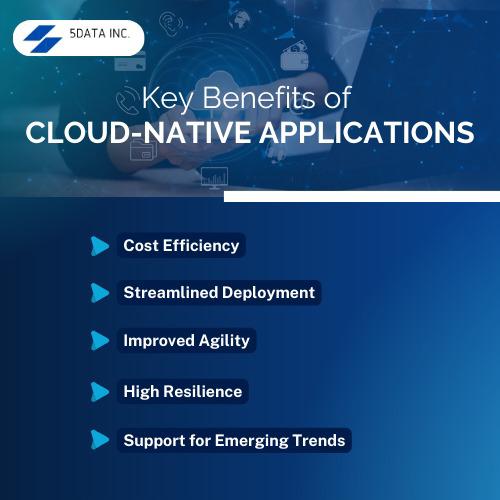Key Takeaways
- Cloud-native applications use CI/CD pipelines, containerization, and microservices architecture to enable rapid development and efficient resource use.
- By leveraging resources efficiently and adopting technologies like AI, ML, and edge computing, cloud-native applications reduce operational costs and enhance agility.
Cloud-Native Applications
Cloud-native applications are designed to utilize the capabilities of cloud infrastructure and services fully. Unlike traditional monolithic applications, cloud-native systems rely on independent services (microservices) and serverless computing. This design approach empowers development teams to build, test, and deploy applications rapidly while ensuring high availability and scalability.
Cloud-native applications are characterized by:
- Containerization: Applications are packaged into containers, such as Docker, which encapsulate all dependencies and ensure consistent execution across different environments.
- Modular Architecture: Breaking down applications into smaller, independent services enhances modularity, improves maintainability, and allows for independent scaling and updates.
- Dynamic Orchestration: Cloud services like Kubernetes provide powerful orchestration capabilities, automating the deployment, scaling, and management of containerized applications.
- Continuous Integration/Continuous Delivery (CI/CD): Cloud-native development heavily relies on CI/CD workflows, enabling frequent and automated releases of new capabilities and updates.
Cloud computing enables continuous integration, allowing software developers to streamline software development workflows and deliver updates more efficiently. We offer comprehensive application development services to help businesses build efficient and user-friendly software solutions.
How Cloud-Native Apps Are Revolutionizing Development
The cloud-native approach has profoundly impacted the application development lifecycle in several ways:
- Faster Development Cycles: With CI/CD pipelines and DevOps practices, cloud-native apps allow for quicker iteration and the integration of additional features. This agility empowers businesses to adjust to market requirements swiftly, strengthening their competitive position.
- Efficient Resource Usage: Cloud-native apps ensure optimal resource management by dynamically adjusting based on demand. Technologies like no-server architecture and predictive analytics enhance resource optimization, driving significant cost savings.
- High Availability and Scalability: Cloud-native applications, designed with resilience in mind, utilize distributed cloud architecture to ensure high availability. This robustness is crucial for businesses seeking to maintain seamless operations, even during peak traffic.
- Enabling Businesses with Flexibility: Cloud-native ecosystems empower organizations to scale applications as needed while maintaining performance. This flexibility reduces reliance on the underlying infrastructure, enabling teams to concentrate on innovation instead of hardware maintenance.
- Collaboration Between Developers and Operations Teams: The cloud-native approach fosters collaboration between technical teams and operations teams through shared tools and practices. This synergy enhances productivity and accelerates the application development lifecycle.
Our hybrid cloud development company specializes in delivering flexible and scalable solutions that seamlessly integrate on-premise and cloud environments.

Key Benefits of Cloud-Native Applications
Cloud-native applications offer several advantages that make them indispensable in modern development. These include:
- Cost Efficiency: Lower operational costs by leveraging cloud services and optimizing resource utilization.
- Streamlined Deployment: Simplified deployment processes with automated tools and frameworks.
- Improved Agility: Faster rollouts of updates and new features.
- High Resilience: Built-in fault tolerance through distributed systems and load balancing.
- Support for Emerging Trends: Integration with technologies like machine learning and advanced analytics.
Leveraging Cloud-Native Technologies
To successfully adopt a cloud-native apps, organizations need to:
- Embrace Cloud Platforms: Choose a suitable cloud service (e.g., AWS, Azure, GCP) that aligns with their specific needs and business goals. Engage experts to design scalable and efficient solutions tailored to business needs. Implement strategies that align with business objectives and growth projections.
- Invest in DevOps Practices: Implement strong DevOps practices, including CI/CD workflows, automated testing, and infrastructure-as-code. Automate testing and deployment to streamline the development workflow process.
- Adopt Containerization: Embrace containerization technologies like Docker to package and deploy applications consistently across different environments.
- Embrace Microservices Architecture: Design and develop applications using a microservices architecture to enhance modularity, scalability, and maintainability.
- Monitor Resource Utilization: Use analytics to optimize costs and ensure efficient resource efficiency.
- Leverage Function-as-a-Service (FaaS): Explore FaaS options to optimize resource usage further and reduce operational overhead.
- Seeking Cloud Consulting Services: Engage with experienced cloud solutions consulting to guide the adoption of cloud-native technologies and ensure successful implementation. This emphasis on guidance and support can make the audience feel more confident and reassured in their cloud-native journey.
- Stay Updated with Trends: Regularly adopting emerging cloud-native technologies is an essential requirement to maintain competitiveness and be prepared for the future.
The emphasis on staying informed can make the audience feel more engaged and proactive in their approach to cloud-native development. As the Best software application development company, we focus on creating cutting-edge solutions that drive efficiency and growth for businesses.
The Future of Cloud-Native Applications
The future of cloud-native applications is poised to revolutionize the digital landscape, driven by advancements in containerization, serverless computing, and AI integration. These applications will enable unprecedented scalability, resilience, and agility, empowering businesses to adapt quickly to changing demands. With the continued evolution of DevOps and edge computing, cloud-native solutions will unlock new possibilities for real-time processing and seamless user experiences, shaping the next generation of digital innovation.
The cloud-native applications are constantly evolving, with emerging trends such as:
- Edge Computing: Bringing computation and data storage closer to the source, minimizing delay, and improving performance for applications with real-time requirements.
- AI and ML: Integrating AI/ML capabilities into cloud-native applications to enhance decision-making, automate tasks, and gain deeper insights from data.
- Backend-as-a-Service (BaaS): The continuous growth of BaaS enables the developers to concentrate on coding while removing the need to manage the underlying infrastructure.
- Enhanced Security: Continued advancements in security technologies, such as zero-trust security models and advanced threat detection, enhance the protection of cloud-native applications against cyber threats.
Conclusion
The cloud-native environment has redefined the software engineering lifecycle, empowering businesses to innovate faster, optimize costs, and deliver high-quality services at scale. By embracing cloud-native technologies, organizations can unlock new opportunities, empower their technical teams, and sustain a competitive edge in a constantly evolving market. With thoughtful planning, effective resource management, and the right tools, the transition to cloud-native development can be smooth and highly beneficial, setting the stage for long-term success.
Frequently Asked Questions
What are the main characteristics of cloud-native applications?
Cloud-native applications are built to utilize cloud platforms, designed with modular microservices, and optimized for dynamic scaling and automation, offering flexibility, resilience, and efficiency.
How does cloud-native development improve cost efficiency?
Cloud-native applications reduce costs by leveraging on-demand cloud resources, automating workflows, and optimizing resource utilization with technologies like load sharing and Cloud-native computing.
What role do DevOps pipelines play in cloud-native apps?
DevOps pipelines automate code integration, testing, and deployment, enabling faster development cycles while maintaining reliability and quality.

Rasmita Patro
Author
